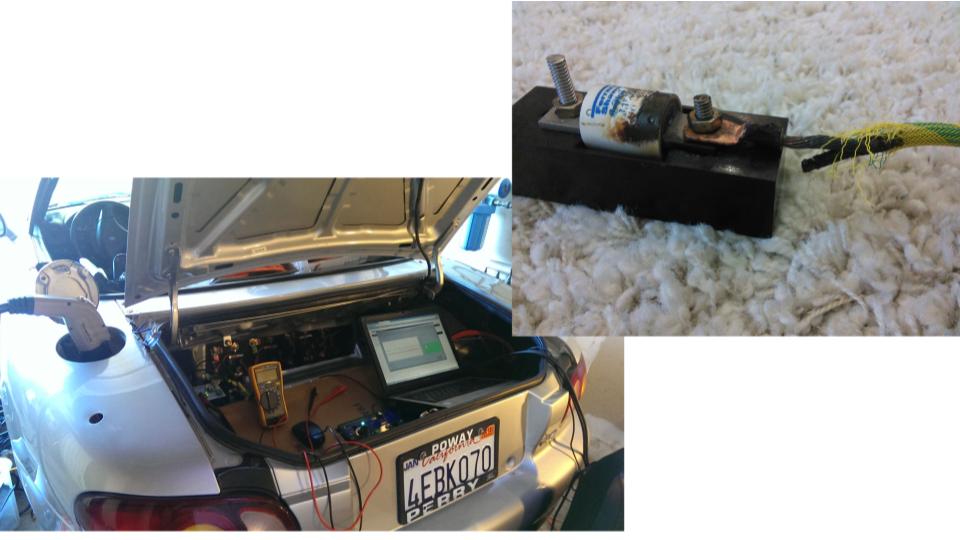TL;DR
EVs require far less maintenance than gasoline-powered (or ICE) cars. Even so, regular maintenance is required; luckily, if you’re the least handy, you can do it yourself. That said, there is one topic we must really talk about—the 12V battery.
It may come as a shock to some, but not only does your shiny new EV have a 2,000+ pound state-of-the-art battery (called the traction pack) that makes the car go, it also has a 12V lead-acid battery straight out of the 19th century. And that 12V battery is frankly the Achilles heel of many (most?) modern cars, including EVs. It may not be as sexy to discuss as 0-60 times, but EV manufacturers should probably focus more on this problem than they currently are.
The Nitty Gritty Details of EV Maintenance
We touched on EV maintenance on May 23 during my column on the costs of operating an EV, so some of this may sound familiar. We will review some of those details, then dive a bit deeper into why 12V batteries can be a problem for an EV.
Consumables
Every car has certain items that need topping off occasionally, and an EV is no different. Below is a bulleted list of various consumables and some hints on tackling their replacement yourself.
- Windshield wipers and washer fluid. If you’re like me, Jiffy Lube takes care of these items when you get your oil changed. Your owner’s manual will tell you where the wiper fluid goes. Replacing the wipers is still a do-it-yourself item, but attaching the replacement wiper blade typically requires a trick, and every manufacturer has a different way of doing it. Thankfully, someone has probably already figured this out for you on YouTube.
- Tires. Let’s face it. EVs are heavier than a typical gas-powered car, and that extra weight leads to accelerated wear. And if you’re like me, the acceleration of an EV is too delicious to resist, leading to even more accelerated wear. Experts say tire wear can be 20% faster on an EV than on a gas-powered car.
- Oil changes. To state the obvious, this is a thing of the past with an EV.
- Air filters. An EV has a motor, but no engine (yes, there is a difference!). It, therefore, follows that there is no air intake filter since there is no engine. Many modern cars will include a cabin filter to clear the air coming from outside into the car’s cabin. This is an easy do-it-yourself item that will be discussed in your owner’s manual. You can also expect that someone has posted a detailed tutorial on YouTube for any popular EV.
- Tune-ups. These are also a thing of the past with an EV.

Unfortunately, EVs still ride on tires, and until we get the Jetson’s flying car, expect your EV to consume your tires about 20% faster than on a last gas-powered car. Photo credit: iStockPhoto.
EV Maintenance
The only regular maintenance for an EV is topping off the windshield washer fluid, cleaning or replacing cabin air filters, and rotating the tires. An EV will also have maintenance items like gearbox oil changes and radiator flushes somewhere around the 100k mile mark. That’s it.
Of course, some items occasionally break or wear out, such as power window motors and the like. One item worth mentioning is the brakes. An EV can be expected to have reduced brake wear due to regenerative braking. Some estimates are that brakes on an EV should last about twice as long as a gas car, reducing the amount of EV maintenance you’ll have to handle.
The 12-Volt Battery
Today’s AGM (Absorbed Glass Mat) lead-acid batteries are far superior to yesteryear’s flooded-cell lead-acid, but lead-acid batteries are still, in automotive terms, ancient technology.
Yet the 12V battery in a modern EV is not only crucial for operation, it is most definitely a single point of failure that is frustrating a lot of drivers when it comes to EV maintenance. Repeated failures of the 12V battery are, in fact, a large cause of buybacks in the industry. It’s that big of a problem.
Why does an EV with a ginormous battery that can power a house even need a 12V battery? Primarily for two reasons. First, there is a legacy going back to the 1950s of using 12 volts to power everything in a car (and before that, it was 6 volts). That ‘everything’ included not only the starter of the engine but also radios, headlights, and in later decades, power windows, seat warmers, GPS Nav systems, and the computers that basically run the car. Until (or even if) those systems become available at different voltage levels, a 12V electrical bus (and probably the 12V battery) will still be required.
It could be argued that with the introduction of the “mild hybrid”, we could start seeing those ancillary devices run at 48 volts, and that would actually have many advantages over 12-volt systems. But it is highly improbable that a seat warmer (as one example) will ever run at 400 volts. According to OSHA, anything over 50 volts is a shock hazard. The 400-volt (and some cars 800-volt) “traction” battery, and the systems that operate at that voltage, is buried so deep within an EV that a typical consumer can’t get to it. But this will never be the case with radios, power windows, touch screens, and seat warmers. Note that Tesla confirmed the Cybertruck would use 48 volts as the “low-voltage” electrical bus for things like heaters and headlights. This is a big step forward, and I hope it takes the industry by storm.
So we’ve established why there is a 12-volt electrical bus, but why specifically is there a 12V battery? And why lead acid? And why is it apparently so difficult to keep them charged in an EV?
Why is there a 12V battery in an EV?
The first generation Tesla Roadster (1.0 & 1.5) didn’t initially have a 12V battery. The 12V battery was added to Roadster 2.0 (starting with VIN 500) in 2009. Note, I’m not referring to the highly-anticipated Roadster 2.0 that has yet to make it to consumer hands in 2023 and unfortunately shares a name with its 2009 predecessor. But the point is, it is possible to ditch the 12V battery completely. It’s noteworthy that not one EV manufacturer in 2023 does so. The reason why is actually pretty simple.
The main traction battery is far more costly and integral to the car, and isolating it when it isn’t in use is more critical to EV manufacturers’ bottom line than the cost (in terms of dollars and mass) of adding a 12V battery. What isolates the traction battery while the car is “off” is called a contactor, but for simplicity and brevity, we’re not going to discuss why the contactor is used to isolate the traction pack while the car is “off.” All you need to know is that the traction pack is isolated when the car is “off” to protect it.
If the traction pack is isolated, something needs to be left “on” while the car is “off” to do everything we expect modern cars to do, like unlocking by clicking the key fob or even simply walking up to the car. That ‘something’ is the 12V battery.
Why lead-acid?
In a word, legacy. The automotive industry has had 100 years of it with the lead acid battery. Tesla has started to replace its 12V lead-acid batteries with 12V lithium-ion batteries. This is a bit more expensive, and it absolutely solves one problem. Maybe that’s the right solution, but it has yet to become an industry trend. Here’s to hoping it catches on.
Why is it so difficult to keep a 12V battery charged in an EV?
Now we come to the all-important question of why it is so difficult to keep those 12V batteries charged. In an ICE-powered car, the 12V battery is maintained by the alternator. If the engine is running, the alternator is powering the 12V electrical bus and maintaining the battery’s charge. But in an EV, the charge on the 12V battery is maintained by something called a DC-DC converter.
The automotive industry has had 100 years to perfect the alternator. We don’t (yet) have that legacy for DC-DC converters. Furthermore, the design of the typical DC-DC converter is such that the output stage (at 12V) is pretty sensitive to the load. And charging for the optimum life of a 12V lead-acid battery is highly dependent on the proper voltage. So while you are driving down the road, the DC-DC converter in your EV is charging the 12V battery, but when you ask for more power from the 12V electrical bus (because you turned up the heater, as an example), the DC-DC converter struggles a bit to maintain the proper voltage for optimal charging of the battery. And so the life of the 12V battery suffers.

Getting the 12V electrical bus to properly charge off of the main traction pack was the hardest part of my Miata EV conversion. And a few high-current fuses. Photo credit: John Higham.
When I converted a Miata to electric, I went through four 12V lead-acid batteries and two DC-DC converters before I came close to a workable solution. Honestly, getting the 12V system to behave was the most difficult part of the conversion.
So what does this mean for today’s EV driver who’s determined to tackle basic EV maintenance on their own? To state it as monosyllabically as possible, when the 12V battery in your EV “dies”, the car becomes a glorified boat anchor. It can be “jumped”, but many manufacturers will discourage this because of something called in-rush current. I used to carry a self-made 12V battery fashioned out of AAA cells to jump my Miata, because it had enough power to close the contactors yet not enough current to do any damage from the in-rush phenomenon.
If all that sounds like too much effort, you can simply buy an inexpensive 12V battery tester and make it a monthly (or quarterly) habit during your regular EV maintenance. At a minimum, you should be aware of this common issue. Taking the next step, if your car exhibits unusual activity or displays warnings, the 12V battery is one of the first things to suspect and test. This is because everything in the car that isn’t turning the wheels operates at 12V. If the voltage starts to drop because of a failing battery, lots of things can self-report as failing when in reality, it’s just that there is insufficient voltage to operate the car. Get it taken care of as soon as possible, lest you too become stranded on a long and lonesome highway, east of Omaha.
Modern ICE cars also have 12V battery issues because modern cars have so many systems that are never powered down, even when the car is off. It’s a big enough problem that many vehicles come with two 12V batteries. To me, that’s just lazy engineering. But it is also reality.
Next week we’ll talk about government EV incentives, and how they can help you get into an EV.








0 Comments